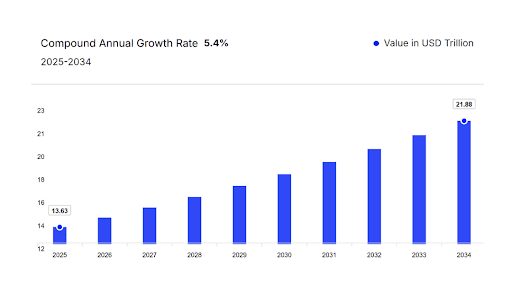
FMCG: Global Export and E-commerce Trends 2025
The FMCG industry is entering a booming stage with strong export trends and the rise of global e-commerce in 2025. This article will analyze in detail the opportunities, challenges, and strategies that help businesses take advantage of FMCG trends, expand markets, and achieve sustainable growth.
1. FMCG – What’s outstanding in the fast-moving consumer goods industry in 2025?
The FMCG (Fast-Moving Consumer Goods) industry always plays an important role in meeting consumers’ daily essential needs. Understanding what FMCG is and the key highlights of the FMCG industry in 2025 will help businesses seize growth opportunities and adapt to new consumption trends.
1.1. What is FMCG? Market overview of the FMCG industry
FMCG (Fast-Moving Consumer Goods) refers to essential consumer products with moderate value but high demand, purchased repeatedly. These are goods closely tied to daily life such as food, beverages, personal care products, or household items.
According to Expert Market Research, the global FMCG market reached about USD 12.93 trillion in 2024 and is expected to grow 5.4% annually between 2025–2034. This shows that FMCG not only maintains stability but also expands in scale thanks to convenient, fast, and sustainable consumption trends.
 In Vietnam, data from NielsenIQ recorded a 16% growth in FMCG during Tet 2024 compared to pre-Tet. Especially, food and beverage categories continue to account for the majority of FMCG revenue. At the same time, modern channels such as supermarkets, convenience stores, and e-commerce are increasingly playing an important role in reaching consumers.
In Vietnam, data from NielsenIQ recorded a 16% growth in FMCG during Tet 2024 compared to pre-Tet. Especially, food and beverage categories continue to account for the majority of FMCG revenue. At the same time, modern channels such as supermarkets, convenience stores, and e-commerce are increasingly playing an important role in reaching consumers.
The FMCG market this year is expected to thrive thanks to the rise of green products, recycled packaging, healthy foods, and low-sugar beverages. Alongside, e-commerce continues to act as a “lever” helping businesses expand markets and reach consumers faster.
1.2. Key product categories in the FMCG industry
In the 2025 FMCG landscape, not all product groups grow equally. The most prominent in the FMCG industry are packaged foods, beverages, personal care, and household products. This answers the common question: “What products are included in FMCG?” They are essential goods, purchased frequently, and account for a large part of household spending.
Current trends show that consumers prioritize health-friendly FMCG products such as healthy foods, low-sugar drinks, or organic products. Within FMCG, this is a fast-growing segment thanks to modern lifestyles and increasing nutritional awareness.
In addition, natural and safe personal care and household products are also gradually gaining ground. FMCG businesses have caught up with this trend by innovating eco-friendly products and optimizing recycled packaging. This not only enhances the shopping experience but also helps brands maintain their position in the global FMCG industry.
In 2025, the FMCG industry will not only focus on consumption speed but also move toward green products, sustainable packaging, and modern sales channels. This is the time for FMCG businesses to innovate, optimize strategies, and win over consumers with both convenience and sustainable values.
2. Factors affecting the FMCG industry market
In 2025, the FMCG market faces many opportunities and challenges, directly influenced by changes in consumer behavior, digital technology, and global economic–political factors.
2.1. Changes in consumer behavior
One of the biggest factors shaping FMCG today is consumer shopping behavior. If price was the priority before, now health, experience, and sustainable values take precedence.
When exploring what FMCG is, we can see that it is not only about essential goods but also products reflecting lifestyles. Therefore, this shift forces businesses to innovate products and marketing strategies to meet new expectations.
2.2. Digital technology and e-commerce driving FMCG growth
It is undeniable that technology and e-commerce have created a leap for the FMCG industry. Consumers increasingly prefer shopping via online supermarkets, e-commerce platforms, and mobile apps. This not only broadens reach but also helps FMCG optimize supply chains, reduce distribution costs, and personalize customer experiences.
 E-commerce is considered the “lever” for FMCG businesses to achieve outstanding growth in 2025 and beyond.
E-commerce is considered the “lever” for FMCG businesses to achieve outstanding growth in 2025 and beyond.
2.3. Impact of macroeconomics and international trade policies
Besides consumer behavior and technology, macroeconomic factors also directly impact FMCG. Exchange rate fluctuations, logistics costs, or international trade policies can open export opportunities but also pose risks. Businesses need to clearly understand which FMCG products have potential to prioritize suitable strategies.
In particular, free trade agreements (FTA) will help the FMCG industry expand globally but also require stricter compliance with quality standards.
In summary, the FMCG market in 2025 is shaped by intertwined factors from consumer behavior, technology, to macroeconomics. Businesses that clearly understand “what products are included in FMCG” and leverage new trends will have many opportunities to break through.
3. FMCG export trends 2025 – Accelerating thanks to cross-border e-commerce
The FMCG industry is entering a period of strong growth as cross-border e-commerce becomes a new “launchpad.” With the characteristics of being essential, moderately priced, but high-demand, FMCG always maintains strong market appeal.
3.1. E-commerce expands the global “gateway” for fast-moving consumer goods
In 2025, cross-border e-commerce promises to be an important driver of FMCG industry growth. Platforms like Amazon, Alibaba, or Shopee Global open opportunities for Vietnamese products to directly reach millions of international consumers.
Thanks to this, FMCG businesses not only expand in scale but also increase competitiveness by significantly optimizing intermediary costs. This is one of the answers to the question “What is FMCG and why is it becoming an increasingly attractive industry?”
Read more: Boost revenue with FMCG on Amazon
3.2. Customizing products & packaging to conquer each market
However, to effectively leverage online export channels, businesses need to focus on product localization. This includes adjusting flavors, formulas, and especially packaging.
 Consumers in Europe, the US, or Japan often pay attention to clear labeling and safety standards such as FDA, ISO, or HACCP. Meanwhile, Southeast Asian markets prioritize practical design and reasonable prices. Personalizing and localizing products will help FMCG brands establish credibility and penetrate new markets more easily.
Consumers in Europe, the US, or Japan often pay attention to clear labeling and safety standards such as FDA, ISO, or HACCP. Meanwhile, Southeast Asian markets prioritize practical design and reasonable prices. Personalizing and localizing products will help FMCG brands establish credibility and penetrate new markets more easily.
Read more: FMCG industry – Don’t let your packaging become a forgotten weapon
3.3. Smart logistics & supply chains – The key to boosting exports
Beyond products, logistics also plays a key role. FMCG products have short life cycles and fast demand, so businesses need to optimize cold transport, warehousing, and international fulfillment services.
Last-mile costs also need tight control to maintain competitive pricing. A smart supply chain applying AI and IoT will be a major advantage for FMCG businesses on the global expansion journey.
2025 opens breakthrough opportunities for FMCG exports, with cross-border e-commerce becoming the main growth driver. To go global, businesses need to flexibly adapt to each market’s tastes while upgrading supply chains and smart logistics.
4. Opportunities and challenges for Vietnamese FMCG businesses
The FMCG industry in Vietnam is entering a promising phase as consumer demand surges. However, businesses also face significant challenges if they want to break through and assert their position in the global market.
4.1. Advantages of Vietnamese FMCG businesses in exports
The biggest strength of domestic FMCG businesses lies in competitive production and labor costs. Vietnam has abundant agricultural resources, favorable for developing familiar FMCG products such as packaged foods, beverages, and personal care products.
When understanding clearly what FMCG is and its characteristic “fast consumption, frequent repetition” businesses can leverage this advantage to attract international customers.
4.2. Barriers businesses need to overcome
Alongside advantages, businesses face many difficulties in exporting consumer goods. Major markets like the US, EU, or Japan set strict standards for food safety and international certifications (ISO, HACCP, FDA).
 Additionally, international logistics costs and complex import-export procedures can drive up prices. If products are not localized to suit consumer tastes—from packaging, labeling, to flavors—their competitiveness will also decline.
Additionally, international logistics costs and complex import-export procedures can drive up prices. If products are not localized to suit consumer tastes—from packaging, labeling, to flavors—their competitiveness will also decline.
4.3. Optimal strategies to break through
To overcome barriers, FMCG businesses need to prioritize product localization and personalization strategies. Packaging must not only be attractive but also transparent, meeting each country’s standards.
At the same time, leveraging cross-border e-commerce reduces dependence on traditional distribution channels and enables direct consumer access. Investing in smart logistics, international warehousing, and flexible delivery services will be the key to enhancing export efficiency.
With advantages in cost, resources, and growth potential, Vietnamese businesses can absolutely reach far in the global FMCG industry. The important thing is to proactively adapt, overcome challenges, and continuously innovate.
5. FMCG 2025: A strong transformation in Vietnam
2025 is forecasted to be a milestone year marking a breakthrough in the FMCG industry in Vietnam. With the advantage of a young population, improving incomes, and booming online shopping habits, the domestic market is becoming an attractive destination for both local and international brands.
Understanding what FMCG is helps businesses leverage the nature of the fast-moving consumer goods industry: moderate value, high repeat demand, and short product cycles. Familiar FMCG items such as packaged foods, beverages, and personal care products are increasingly important in Vietnamese shopping baskets.
It is clear that Vietnam’s FMCG industry is entering a strong transformation. By combining domestic market advantages with opportunities from e-commerce and cross-border exports, businesses can absolutely establish their position on the global map.
AGlobal – the best cross-border e-commerce solution for businesses.
Sign up for free 1-on-1 consultation tailored to your business industry Here!
